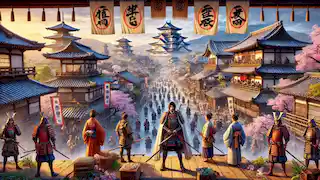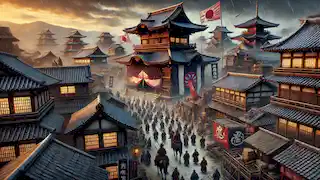The Tale of the Heike
Reading time: 7 min

About this story: The Tale of the Heike is a Historical Fiction from Japan set in the Medieval This Dramatic tale explores themes of Courage and is suitable for All Ages. It offers Historical insights. An epic saga of the Taira clan's rise and fall during Japan's Genpei War.
The Tale of the Heike is a classic epic of Japanese literature, chronicling the rise and fall of the Taira (Heike) clan during the Genpei War (1180-1185). This war marked the end of the Heian period and the beginning of the Kamakura era, ultimately leading to the establishment of the Kamakura shogunate. The tale, a rich tapestry of heroism, tragedy, and the impermanence of life, is a cornerstone of Japanese culture, capturing the essence of samurai ethos and the fleeting nature of power and glory.
The Rise of the Taira
The Taira clan, under the leadership of Taira no Kiyomori, rose to unprecedented power during the late Heian period. Kiyomori, a shrewd and ambitious warrior, leveraged his military prowess and political acumen to secure key positions within the imperial court. His success was marked by strategic alliances and ruthless elimination of rivals, which solidified the Taira's dominance over the aristocracy and the imperial family.

However, Kiyomori's ascent was not without its consequences. His accumulation of power and wealth fostered resentment among the nobility and other warrior clans, particularly the Minamoto (Genji) clan. This animosity laid the groundwork for the eventual conflict that would engulf the nation in a bitter civil war.
The Outbreak of War
The Genpei War began in 1180 when Prince Mochihito, a member of the imperial family dissatisfied with Kiyomori's influence, issued a call to arms against the Taira. Supported by the Minamoto clan, this rebellion quickly escalated into a nationwide conflict. The Minamoto, led by Minamoto no Yoritomo, rallied various warrior factions and provincial lords to their cause, challenging the Taira's supremacy.
The early stages of the war saw the Taira clan securing several significant victories. Their control over the capital, Kyoto, and key provinces allowed them to maintain the upper hand. However, the tides of war are ever-changing, and the Minamoto forces, driven by a deep-seated desire for revenge and justice, began to gain momentum.
Battles and Betrayals
The Genpei War was marked by numerous battles and strategic maneuvers, each contributing to the unfolding drama of the Heike's downfall. One of the most significant encounters was the Battle of Kurikara in 1183, where the Minamoto forces achieved a decisive victory. The Taira army, caught off guard and outmaneuvered, suffered heavy losses, marking a turning point in the conflict.

Amidst the chaos of war, betrayal and shifting loyalties became common. The Taira clan, once unified under Kiyomori's leadership, began to fracture. Internal dissent and the defection of key allies weakened their position. In contrast, the Minamoto clan, under the astute leadership of Yoritomo, capitalized on these divisions, forging alliances and consolidating their power.
The Siege of Kyoto
By 1184, the Minamoto forces had grown significantly stronger, enabling them to launch a concerted campaign against the Taira stronghold in Kyoto. The siege of the capital was a brutal and protracted affair, marked by fierce fighting and significant casualties on both sides. The fall of Kyoto signaled the beginning of the end for the Taira clan.

Forced to flee, the Taira remnants retreated westward, seeking refuge in their ancestral lands. The once-mighty clan was now a shadow of its former self, their power eroded, and their morale shattered. The Minamoto, relentless in their pursuit, continued to press their advantage, determined to bring the conflict to a definitive conclusion.
The Final Battle
The climactic battle of the Genpei War took place in 1185 at Dan-no-ura, a narrow strait off the coast of Shimonoseki. The Taira fleet, led by Taira no Munemori, faced off against the Minamoto forces in a naval engagement that would determine the fate of the two clans. The battle was fierce and chaotic, with both sides displaying remarkable valor and tenacity.

Despite their desperate efforts, the Taira were ultimately overwhelmed by the superior tactics and numbers of the Minamoto. As the tide turned against them, many Taira warriors chose to end their lives rather than face capture. Among them was Taira no Tomomori, who, bound by the samurai code of honor, leaped into the sea with an anchor tied around his waist.
The Fall of the Heike
The defeat at Dan-no-ura marked the final collapse of the Taira clan. With their leaders dead and their forces decimated, the remnants of the once-powerful family scattered or were captured. The Minamoto emerged victorious, their supremacy unchallenged, and Yoritomo soon established the Kamakura shogunate, ushering in a new era of military governance in Japan.

The Tale of the Heike, however, is not just a chronicle of war and conquest. It is a poignant reminder of the transient nature of life and power. The Heike's rise and fall, depicted in vivid detail, underscore the Buddhist concept of impermanence (mujō). The epic is replete with scenes of heroism, loyalty, and sacrifice, but also of tragedy, loss, and the futility of worldly ambitions.
Legacy and Reflection
The Tale of the Heike has endured through the centuries as a seminal work of Japanese literature and culture. Its themes resonate with universal truths about human nature, ambition, and the inevitable passage of time. The epic has been adapted into various forms, including Noh and Kabuki theater, literature, and film, each interpretation adding new layers of depth to the timeless story.
The characters of the Heike, both heroes and villains, are remembered for their complex humanity. Figures like Taira no Kiyomori, whose ambition led to both great success and ultimate downfall, and Minamoto no Yoshitsune, celebrated for his martial prowess and tragic fate, continue to capture the imagination of readers and audiences.
The Aftermath
In the wake of the Genpei War, Japan underwent significant political and social transformations. The establishment of the Kamakura shogunate marked the beginning of a new era in which the samurai class held predominant power. This shift laid the foundations for centuries of warrior rule, influencing the nation's history and culture profoundly.
The Heike's story also served as a cautionary tale for subsequent generations. The ephemeral nature of their glory, contrasted with the enduring values of loyalty, honor, and resilience, provided moral lessons that transcended the specifics of the historical events.
Echoes of the Past
Today, the Tale of the Heike continues to inspire and educate. Its lessons on the rise and fall of power, the impact of individual actions, and the inexorable march of time remain relevant. The epic is a bridge to Japan's past, offering insights into the cultural and historical contexts that shaped the nation.
The tale's enduring appeal lies in its rich narrative and the emotional depth of its characters. It serves as a reminder that while empires may rise and fall, the stories of those who lived, fought, and died continue to echo through history, offering wisdom and reflection for future generations.
Conclusion
The Tale of the Heike stands as a monumental work, capturing the essence of an era defined by conflict and change. Its narrative weaves together the complexities of human ambition, the sorrow of loss, and the fleeting nature of power. Through its vivid depictions of battles and personal struggles, the epic offers a timeless exploration of the human condition, resonating with readers and audiences across the ages.
In recounting the rise and fall of the Taira clan, the tale invites us to reflect on our own lives and the impermanent nature of our achievements. It reminds us that history is not just a series of events, but a tapestry of stories that continue to shape our understanding of the world and ourselves.
The Tale of the Heike is more than a historical account; it is a living legacy that continues to inspire, teach, and move those who encounter its pages. Its message of impermanence and the enduring value of honor and courage remains as relevant today as it was centuries ago, ensuring that the story of the Heike will never be forgotten.


















